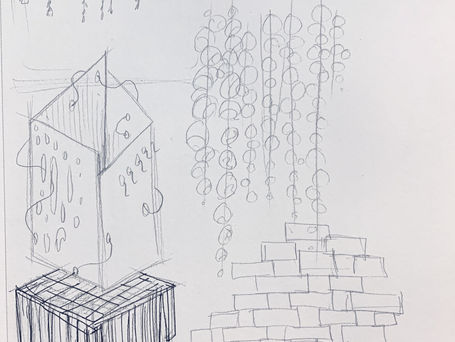RESEARCH & IDEATION
Secondary, Primary, and Ideas
From the summer and into the start of the first semester, my research started off very broad with multiple sources. I wrote out a summary of the information with my intentions, and conducted interviews for primary research. This information fed a process of sketching and creation, many being nonsensical, then leading into things that make sense.
SECONDARY RESEARCH
This began from my own lived experience in the Canadian medical system and processes, existing mental health data, mental illness, Traditional and Western healing, designing for a crisis, and art therapy. Here is a summary of each these general topics researched.
01
The Medical System
Getting into the public health care system starts from medical school, to a residency, to practice with expectation of continued learning. Government funding for public healthcare is low, and there are less private healthcare options. Generally, the system faces a problem of investment.
In the healthcare system, a culture exists that encourages them to push through personal problems to focus on patient care. They value overworking and ability to manage all responsibilites, all the time.
Fear also exists in a system where there is potential to be reprimanded, privacy concerns, and ethical dillemmas. Professionals are asked to go off the job if their mental health is suffering...
02
Mental Health Data
What is already known is clear, physicians have a higher rate of anxiety, depression, and other mental illnesses that often relate to the experiences of their practice. There is a culture amongst physicians to “cloak experiences of anxiety, worry, and shame, rationalizing significant feelings of distress as part of their identity as physicians, [they] loathe to draw attention to self-perceived weakness” (C. Moutier, 2018).
Many studies come to similar conclusions, physicians require more actionable help for themselves and in the community. Great changes have happened since 2013, but, the problem still exists, suggesting the need for more research, more awareness, and more action.
03
Mental Illness
The COVID pandemic has started a movement to focus on mental health. It is especially focused on healthcare, noticing the burnout and traumatic experiences.
Mental health focus in the healthcare profession is burnout (not a recognized mental illness, but can be a cause), anxiety, and depression. Concerning behaviours are self-medication, isolation, suicidal ideation, repression of emotions, and ineffective work or mistakes (less concerning, but important when other people’s health are involved).
CMA addresses mental health with informational sheets with some care tips. Confidential help lines and therapy exists.
04
Traditional & Western
“The revolution in medicine starts with the revolution of self. The revolution of self begins with an understanding of the body and mind in a way that is rarely explained in today’s mix of electronic media, publications, health news, and cultural beliefs.
The human body functions in mysterious, complex, and intriguing ways, and when we simply understand what to do to support this being, there isn’t much else that we have to do.” - The Science of the Sacred
Both Traditional and Modern Western medical practices have their values. More Traditional practices can be (and are being) considered for the more holistic and personal approach to health and healing.
05
Designing for a Crisis
Thinking of a person in the middle of struggling, where they may not recognize they need help or are not willing to reach out for it. How do you design for someone in this state of mind?
Key points for me for designing for those in a crisis are utilizing:
Storytelling and genuine communication/connection, use of nature, trees, light, and sensory experiences, personalization like offering a time for personal input, safe spaces to vent, recognizing vulnerability and isolation during mental health crises, and art/creativity as positive distraction.
Empathy for all involved is important in every part of the design process.
06
Art Therapy
A 2018 study found students who engage in arts in med school had higher levels of empathy and emotional intelligence, and lower rates of burnout.
Linh Dang states that “Arts in Medicine will help bring back the joy in work and improve outcomes for staff and ultimately the patients.”
Art therapy is a practice that takes participants through a creative experience with no pressure of creating something ‘good’. It focuses on making and being present in the moment. There needs to be a focus on positive life experience, increase in self-worth through a making challenge, and a time to express in a symbolic manner.
PRIMARY RESEARCH
IDEATION
Before going into a specified direction with goals in mind, I take time to sketch whatever comes in mind for the project. These are labelled as ‘blue sky’ concepts; a way to brainstorm without limitation before setting the project with reasoning. In this process, I stumble on some ideas that can be made feasible, of that I can refer to at any point in the project.













